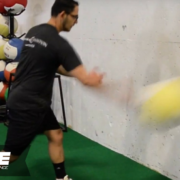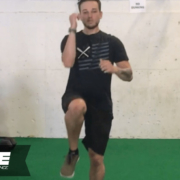5 Sprint Drills Designed for Baseball Players
As we begin to enter the off-season for baseball, many players, parents and coaches are searching for sprint drills for baseball players. One of the common areas baseball players want to work on is speed and getting faster.
With college camps and showcases right around the corner, now is a great time to work on your sprint mechanics!
In this article, I will share with you 5 sprint drills designed for baseball players. Make sure you watch the videos for a great demo and how I coach them.
If you are not a subscriber to Esposito Strength Club, make sure you click here to subscribe so you don’t miss out! You will also get access to all of my free online baseball courses!
Learn From My Mistakes
I remember the first time when I threw up from “speed drills.” I was 16, and was destroyed. Baseball scouts and coaches told me that I needed to work on my sprint mechanics. Luckily I had my 60 yard times and running times from a Perfect Game showcase.
- 7.6 second 60 Yard Dash
- 2.1 second 10 Yard Dash
- Mile time just under 8 minutes
So, like most of you, my parents signed me up for a “Speed Camp.” I was one of 30 kids to one coach. Some random open field in Southern New Hampshire. This coach was a former athlete with no certifications or any further education. He happened to be at one of our fall ball games promoting his Speed Camp.
What Did this Speed Camp Entail?
Day 1. We were outside for an hour. Sprinting. Running laps. Cone drills. More sprints.
I threw up. This speed coach was literally happy I threw up. Like a badge of honor for him.
Every day for 8 weeks, we did the same thing. If I didn’t throw up, the coach would tell me I didn’t work hard enough.
The Results?
I don’t remember the exact numbers, but I know I got slower.
My 60 Yard dash time was above an 8.
My 10 yard was slower.
My mile time was close to 9 minutes.
The worst part… The coach put the blame on me! I was 16. I didn’t know and neither did my parents. Looking back at the “program,” we did nothing to work on my sprint mechanics. I was broken down, weaker, and I did not get better. That is some of the dangers when it comes to “speed camps.”
You Need to Crush the Basics…
So, what are some sprint drills to do? Here are 5 of my go to’s when starting off with an athlete:
The Wall Lean Piston Iso
Nothing sexy about this drill. It is one of my favorites when it comes to coaching athletes on the proper positions for sprinting. If you can’t get repeat this position on a wall, how can you get to this position at full speed?
Take pride in these important sprint mechanic positions!
Download my Top 10 Game Day Nutrition Tips for Baseball Players Here
The Wall Lean Piston Iso is a great teaching tool to create context for the next sprint drills in this blog. When coaching, I will often regress athletes for a set to remind them about this specific position. This allows the athlete to mentally remember where their positions are.
How to Perform The Wall Lean Piston Iso
Linear Bounds
Following our wall drill, our next sprint drill for baseball players is Linear Sprint Bounds. This is a great exercise to work on force into the ground, and vertical power when sprinting. There is also the pre-tension anticipation of your next stride, which adds a ground reaction component as well. Think of these as long stride sprints.
You are trying to spend less time on the ground, and creating a rhythmic, yet powerful sequence throughout your running mechanics.
Great for knee flexion and foot placement like we discuss in the Wall Lean Piston Video above.
How to Perform Linear Bounds
Lean Fall Sprint with Hip Flexion Start
The next sprint drill for baseball players is The Lean Fall Sprint with Hip Flexion continues to build off of our previous videos in this blog. We are constantly working on our sprint positions, especially the knee and foot placement.
Starting off in the exact position we need to get into when hitting the ground is a great way to start off with your lean fall sprint progressions. As a coach, I am able to stop the drill, set positions and reminders, and maintain the integrity of our sprint positions.
Like our videos above, this is great for knee flexion and ground contact time. We like to think of being aggressive with your arms, and pushing force into the ground at contact.
How to Perform the Lean Fall Sprint with Hip Flexion Start
Linear Pulse to Sprint
So far in our previous sprint drills for baseball players, we have set some constraints with specific starting points and isometrics. In the Linear Pulse Start to Sprint, we begin to add in a bit more pre tension and timing for the athlete.
The pulsing helps create tension throughout the body. I like to think of being on a mini trampoline and pushing the floor away. I also want to point out that my head is not doing a ton of up and down movement. Think of a duck on the water, still and calm above the water, but rapid and engaged below!
Let the athlete get some timing in for the pulsing. You can also allow the athlete to choose when they decide to sprint. As a coach, you can also decide on go calls or audible noises. Whatever fits your training program and goals.
How to Perform the Linear Pulse to Sprint
10 Yard Build to 30 Yard Sprint
In our 5th sprint drill for baseball players, we are now performing what I call a free run. The free run allows the athlete to put all the drills from above into effect. This takes away some of the “practice steps” involved from the previous sprint drills.
This drill is designed for the athlete to incorporate their sprint mechanics as they build up slow for 10 yards. Once they reach the 10 yards, then accelerate into a close to max effort sprint for the designated distance.
As a coach, you can adjust the build distance as well as the sprint distance. Depending on the athlete and sport, that can be customized for you.
I typically like the 10-yard build for baseball players as it simulates the time or duration of a pitch. If you are a base runner, you have to turn in the jets and run the bases hard. If you are playing defense, you have to sprint to the gap or back up a base!
How to Perform the 10 Yard Build to 30 Yard Sprint
Putting it All Together
This is a typical set and reps for each of these after a full warmup (not sure what to do for a warmup? Check out My Pre-Game Warm-Up Blog):
- Wall Lean Piston Iso – 2-3 Sets of :10 isometric for each leg
- Linear Bounds – 2-3 Sets of 10-15 Yards
- Lean Fall Run with Hip Flexion – 2-3 Sets of 3 each leg (6 total sprints)
- Linear Pulse Start to Sprint – 2-3 sets of 3 each leg (6 total sprints)
- 10 Yard Build to 30 Yard Sprint – 1 set of 4 Reps
Remember, in the words of Tim Gabbett, work hard and smart. Just because you threw up, doesn’t make it a good “speed” program!
Nick Esposito
Latest posts by Nick Esposito (see all)
- 5 Sprint Drills Designed for Baseball Players - October 8, 2019
- Nutrition for Baseball Performance - September 10, 2019
- The 3 Foundations to Your Nutrition: Macronutrients - August 13, 2019







Great post! I’ve been working on some of these drills myself.
awesome
Great post! I love the variety of sprints you included. It’s really helpful to have specific drills to work on my speed and agility on the field. Can’t wait to try them out during practice!
Great post! I love how you broke down the sprint drills specifically for baseball players. Can’t wait to incorporate these into my training regimen to boost my speed on the field. Thanks for sharing!
Great post! These sprint drills are exactly what I needed to incorporate into my training routine. Can’t wait to see how they improve my speed on the field!
Great insights on sprint drills! I found the variations really helpful for pushing my limits on the field. Can’t wait to incorporate these into my training routine and see the improvements in my speed. Thanks for sharing!
These sprint drills are fantastic! I’ve already incorporated some of them into my training routine, and I’ve noticed a huge improvement in my speed on the field. Can’t wait to see how much further I can push myself with these techniques! Thanks for sharing this!
Great insights! These sprint drills are exactly what I needed to add to my practice routine. Can’t wait to see how they improve my speed on the field! Thanks for sharing!
Great post! I love how these sprint drills are specifically tailored for baseball players to enhance speed and performance on the field. I can’t wait to try these out in my training routine!
Great drills! I love how these sprint exercises focus on both speed and explosiveness, which are so crucial for baseball. Can’t wait to incorporate them into my training!
Great insights! I love how these sprint drills can really enhance a player’s speed and agility on the field. Can’t wait to incorporate them into my training routine. Thanks for sharing!
Great post! I really appreciate the detailed breakdown of each drill and how they target different aspects of speed and agility for baseball players. I’m eager to incorporate these into my training regimen. Thanks for sharing!
Great insights on sprint drills! I particularly love the focus on explosive starts and proper form. Can’t wait to incorporate these into practice to boost our team’s speed on the field. Thanks for sharing!
How many yards is recommended for exercises 3 and 4 ?
Great drills! I love how you broke down the techniques for each sprint. It really helps us understand how to improve our speed on the field. Can’t wait to try these out during practice!
Great drills! I love how you broke down each sprint exercise and explained its benefits for baseball players. I’m definitely going to incorporate these into my training routine, especially the focus on acceleration. Thanks for sharing!
Great post! These sprint drills are a fantastic way to improve speed and agility on the field. I can’t wait to integrate them into my training routine. Thanks for sharing such valuable tips!
These sprint drills look fantastic! I can’t wait to incorporate them into my training routine. The emphasis on proper mechanics is especially helpful for improving speed and injury prevention. Thanks for sharing these insights!
Great drills! I love how these sprint exercises can really enhance speed and agility on the field. Can’t wait to try them out with my team! Thanks for sharing!
Great drills! I love how you broke down each sprint exercise for different skill levels. It’s helpful to see the emphasis on technique alongside speed. I can’t wait to incorporate these into my practice sessions!
Great post! I love the variety of sprint drills you shared, especially the focus on explosive starts. These will definitely help improve my speed on the field. Can’t wait to incorporate them into my training!
Great post! I love how you broke down each drill and explained their benefits for improving speed on the field. I’ve been looking to enhance my sprints, and these exercises seem doable yet effective. Can’t wait to try them out at practice!
Great insights on the sprint drills! I love how you broke down each drill’s benefits for baseball performance. Can’t wait to incorporate these into my training routine. Thanks for sharing!
Great drills! I love how each sprint focuses on different aspects of speed and agility. The variety will definitely keep my training sessions engaging. Can’t wait to try these out with my teammates!
Great post! These sprint drills look like an excellent way to improve speed and agility on the field. I particularly liked the emphasis on explosive starts. Can’t wait to incorporate these into my practice routine! Thanks for the tips!
These 5 drills are fire! 🔥 The Linear Pulse to Sprint had me feeling like a mini trampoline off the line. Incorporating them into my routine – who’s with me? Share your results below, baseball fam!
Delta Executor is lightweight and doesn’t require high system resources.Compared to other executors, it’s considered safe and more stable for long sessions.
Unlike some editing apps, Xingtu maintains high resolution after editing, which is a big plus for social media posts.
Great tips! I especially love the emphasis on explosive starts and acceleration. I can’t wait to try these drills at practice to help improve my speed on the base paths. Thanks for sharing!
Yes the pulsing helps create tension throughout the body.
Great insights! I love how these sprint drills not only improve speed but also enhance overall agility on the field. Can’t wait to try them out with my team!
I have tried these drills higher chance of injuries
CricZ TV is appreciated for providing free access to live sports content without complicated setup. Overall, it’s a handy option for users who want to stay connected to live cricket and sports entertainment on the go.
Zoula TV is especially appreciated for its free access to diverse entertainment categories, including sports, news, and movies. Overall, it’s a convenient option for users looking for an all-in-one streaming experience without the need for multiple apps.
ByeDPI is a lightweight and useful tool designed to help users bypass network restrictions caused by Deep Packet Inspection (DPI). It works efficiently in the background without requiring complex setup, making it suitable for both technical and non-technical users.